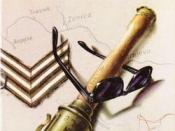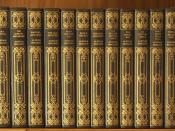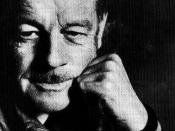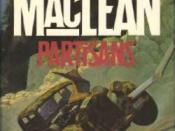GUNS OF NAVARONE Alistair MacLean frequently wrote stories that had the same formula. He wrote stories that take place in a war, use vivid action, and involve a hero fighting incredible odds. The novel Guns of Navarone, supports this idea very well.
Alistair MacLean was born in 1922 in Scotland. At the age of eighteen, he joined the Royal Navy. He began five years of service as a torpedo man in the East Coast Convoy Escorts. His was in the service from nineteen forty-one to nineteen forty-six. His experience in the Royal Navy "â¦informs much of his espionage fiction" (CLC, 258). After the war, he went to college and graduated from the University of Glasgow in nineteen fifty-three. He began his writing career two years later in nineteen fifty-five. Guns of Navarone, "MacLean's most famous and popular novel", was written in nineteen fifty-seven. He died of heart failure in nineteen eighty-seven.
A repeating thing in all of MacLean's works, is they all are about World War Two (Contemporary Authors). In this particular novel, during the World War, five men are assembled to destroy giant guns on an island called Navarone which are used to destroy incoming boats. If this mission is not completed, fifteen hundred soldiers would be killed by Germans. (Guns of Navarone). "Many of MacLean's novels reveal a nostalgia for the days of WWII, a period in which the author's themes of espionage and heroics thrive." (Contemporary Popular Writers, 265).
Another repeating aspect of MacLean's writings, is the use of vivid action. He uses action, suspense, and plot twists. "MacLean established himself as an excellent thriller writer with a keen eye for fast paced, suspenseful narrative." Guns of Navarone leads the reader on to its explosive climax, bringing the reader close to its heroes by filling them with a sense of pity, hope, and courage (CPC, 265). He also paints very detailed and spectacular visual pictures of perils and danger (CLC, 360). The hostile climate is used very descriptively. He describes a bad storm that the heroes faced while aboard a small boat, which results in the crash landing on the island of Navarone (G of N, 72). The scaling of the cliffs is the high pt of the novel. It's also is "â¦one of the great scenes out the entire corpus of the novel." The motive that is stressed during this scene, is fear (CLC, 360). Throughout the whole book, there are gunfights and other events. At one point in the novel, a traitor is revealed to be in the group of heroes and could mean the end of their plans. The traitor had to be executed by one of the member of the group.
A third repetitive characteristic of MacLean's stories is they involve incredible odds that the heroes have to overcome. "â¦heroes struggle to overcome incredible dilemmas through combination of intelligence and physical force." (CLC, 258). "His novels tend toward a single design, that of a good man fighting evil struggling against incredible odds." (CPW, 265). The whole mission the five men have to complete is suicide. The first obstacle they have to overcome is the unclimbable cliff on the borders of the island of Navarone. Everyone who gave them information on the mission before they accept it says it's impossible but the leader of the group believes it can be done. The cliff is rocky and rugged, and the worst part about it is it's straight up (G of N). Another obstacle is the outnumbering of them by the German soldiers. The soldiers are looked as ruthless enemies and there is a ridiculous ratio of German soldiers to the heroes. If this seems bad enough, only a little bit into the novel, one of the members falls and breaks their leg. With only five members, they outcome looks bleak. They are expected to somehow infiltrate a heavily defended base of the Germans' where their biggest and best weapons are held. Another discouragement is there was already a fleet of soldiers who had tried to complete the mission who had failed. As if this wasn't enough, the heroes also had to overcome inner struggles that plagued them. "He often pitted his protagonists against an adverse environment and their own internal terrors to illustrate the power of humanity's raw courage." (CLC, 258).
MacLean is looked upon as having a single design for all his works. Three characteristics of his novels, set in WWII, the use of vivid action, and the incredible odds faced by the heroes, are shown very well in the novel The Guns of Navarone.
Works Cited "Alistair MacLean". Contemporary Authors. 1998.
"MacLean, Alistair (Stuart)". Contemporary Popular Writers. 1997 ed.
Lee, Robert A. "Alistair MacLean". Contemporary Literary Criticism. Vol. 13. 360.
MacLean Alistair. Guns of Navarone. New York: Fawcett Crest, 1956.
"Alistair MacLean". Contemporary Literary Criticism. Vol. 63. P.258.





